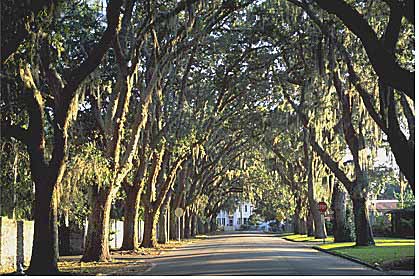Home > Health and maintenance > Improve health > Fertilizing established trees
Fertilizing established trees
Many trees in managed landscapes are able to scavenge for enough elements once they become established due to their extensive root systems (See: more on root systems). They have access to naturally occurring elements as well as elements applied as fertilizer to the lawn, shrubs, and garden and may need no additional fertilizer. Some species such as hollies, crapemyrtle, maples, Chinese elms and others appear yellow and chlorotic in some circumstances unless fertilized. These and trees like them can benefit from regular fertilization, at least until established.
Adding fertilizer that contains nitrogen (the first number on a fertilizer label) under the canopy can increase growth rate and provide greener foliage on young and medium-aged trees; this can be a reasonable objective. However, increasing growth on mature trees (see photo) may not be desirable. More growth means increased demands on the tree to maintain more living cells and could result in more pruning required. This could actually lead to decline under certain circumstances.
Mature trees can benefit from application of certain fertilizers in instances where there is a deficiency. However, simply adding fertilizer around otherwise healthy mature trees may not accomplish anything. Adding fertilizer, especially nitrogen, around stressed or root damaged trees can be harmful unless you have determined that the stress is due to nutrient deficiency.
Harm can occur when a tree with low reserves due to root damage or old age attempts to incorporate nitrogen into cell components. Since this process requires energy expenditure, reserves can be lowered further. This could lead to a decline in health. Trees with low reserves have reduced ability to fight the effects of injury and pests.
When all branches on mature trees have foliage to their tips, and foliage is green, there is little reason to add fertilizer. When foliage shows deficiency symptoms, determine what element is missing (See: online tool) and apply treatments accordingly. When you suspect a deficiency, have the soil or foliage tissue tested for important elements before prescribing a fertilizer treatment.
Some contamination of surface waters has been attributed to fertilizer runoff from asphalt and concrete surfaces. This occurs when fertilizer is carelessly or inadvertently applied to the hardscape. To reduce the chances for runoff, apply fertilizer very carefully where the fertilizer surface meets hardscape. You might apply fertilizer by hand in these sensitive locations, or you could use a deflection shield.
Two studies showed that tree growth was enhanced more by broadcast application than placing fertilizer below the soil surface (Chadwick et al., 1957; van de Werken, 1984); whereas others showed that method of application had no effect on tree or shrub growth (Davey, 1930; Gilman, 1989; Hensley et al, 1988, Neely, 1970). No studies showed more growth from subsurface application than from broadcast surface application.
See: related information

